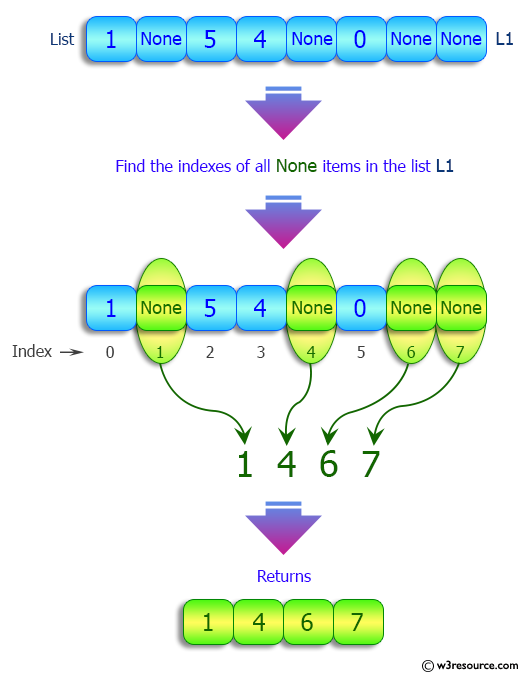Python: Find the indexes of all None items in a given list
Indexes of None in List
Write a Python program to find the indexes of all None items in a given list.
Visual Presentation:

Sample Solution:
Python Code:
# Define a function 'relative_order' that finds the indexes of all None items in a list.
def relative_order(lst):
# Use a list comprehension to iterate over the indexes 'i' and elements in the list 'lst'.
# For each element, check if it is equal to None, and if it is, include its index 'i' in the result list.
result = [i for i in range(len(lst)) if lst[i] == None]
# Return the list of indexes of None items.
return result
# Define a list 'nums' containing various elements, including None values.
nums = [1, None, 5, 4, None, 0, None, None]
# Print a message indicating the original list.
print("Original list:")
# Print the original list 'nums'.
print(nums)
# Print a message indicating the purpose of the following lines of code.
print("\nIndexes of all None items of the list:")
# Call the 'relative_order' function to find the indexes of all None items in the list 'nums'.
print(relative_order(nums))
Sample Output:
Original list: [1, None, 5, 4, None, 0, None, None] Indexes of all None items of the list: [1, 4, 6, 7]
Flowchart:

For more Practice: Solve these Related Problems:
- Write a Python program to count the number of None values in a list and output their indices.
- Write a Python program to replace all None values in a list with a default value, returning both the new list and the indices where replacements occurred.
- Write a Python program to remove all None elements from a list and produce a separate list containing their original indices.
- Write a Python program to split a list into two lists—one containing None values (with indices) and one with the non-None elements.
Previous: Write a Python program to check if a given string contains an element, which is present in a list.
Next: Write a Python program to join adjacent members of a given list.
Python Code Editor:
What is the difficulty level of this exercise?
Test your Programming skills with w3resource's quiz.
